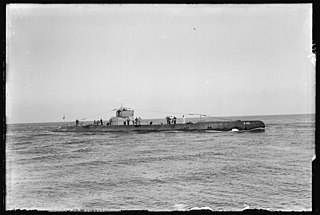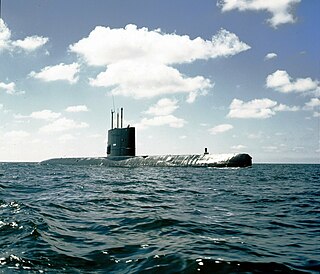
USS Icefish (SS-367), a Balao-class submarine, was a ship of the United States Navy named for the icefish, any member of the family Salangidae, small smeltlike fishes of China and Japan. These fish are also collectively known as whitebait.

HMS P47 was a Royal Navy U-class submarine built by Vickers-Armstrong. She was transferred to the Royal Netherlands Navy before completion and renamed HNLMS Dolfijn.

O 19, laid down as K XIX, was an O 19-class submarine of the Royal Netherlands Navy that saw service during World War II. O 19, along with her sister ship O 20, were the first submarines in the world to be equipped with a submarine snorkel that allowed the submarine to run its diesel engines while submerged.
HNLMS K XI was the first of three K XI-class submarines of the Royal Netherlands Navy, built to serve as a patrol vessel in the Dutch colonies.

HNLMS K X was one of the three K VIII-class submarines of the Royal Netherlands Navy, built to serve as a patrol vessel in the Dutch colonies.

O 24, laid down K XXIV was an O 21-class submarine of the Royal Netherlands Navy that saw service during World War II. The most famous occupant of O-24 was Piet de Jong, who was the commanding officer from 1944 until 1946 and who later became Minister of Defence in 1963 and served as Prime Minister of the Netherlands from 1967 until 1971.

O 13 was an O 12-class submarine of the Royal Netherlands Navy that saw service during World War II. She was built by the Koninklijke Maatschappij De Schelde of Vlissingen. She was one of many Dutch ships doing convoy duty during the Spanish Civil War. At the time of the German invasion of the Netherlands, O 13 was on patrol off the Dutch coast and was attacked by German planes on multiple occasions. After fleeing to England, the submarine was lost during a patrol on the North Sea.

O 2 was an O 2 class patrol submarines of the Royal Netherlands Navy. The ship was built by De Schelde shipyard in Flushing.

O 1 was a Holland 7P patrol submarine of the Royal Netherlands Navy. The ship was built by the De Schelde shipyard in Flushing and was the first submarine in the Dutch navy. It had a diving depth of 25 metres.

K I was a unique patrol submarine of the Royal Netherlands Navy. The ship was built by De Schelde shipyard in Flushing. The boat had a diving depth of 40 metres (130 ft).

K III was a K III-class patrol submarine of the Royal Netherlands Navy. The ship was built by De Schelde shipyard in Flushing.

O 21, laid down K XXI was an O 21-class submarine of the Royal Netherlands Navy that saw service during World War II. During the war she sank several ships, among them the German submarine U-95.
O 11 was a O 9-class patrol submarines of the Royal Netherlands Navy. The ship was built by Fijenoord shipyard in Rotterdam.
O 9 was an O 9-class patrol submarines of the Royal Netherlands Navy. The ship was built by Koninklijke Maatschappij De Schelde shipyard in Flushing.

K XIII was a K XI class patrol submarine of the Royal Netherlands Navy. The ship was built by Fijenoord shipyard in Rotterdam.

K XII was a K XI class patrol submarines of the Royal Netherlands Navy. The ship was built by Fijenoord shipyard in Rotterdam.

HNLMS Dolfijn was a Dolfijn-class submarine of the Royal Netherlands Navy.

HNLMS Zwaardvis (S806) was a Zwaardvis-class submarine of the Royal Netherlands Navy.

K XV was one of five K XIV class submarines built for the Royal Netherlands Navy. She served during World War II.

K XVIII was one of five K XIV-class submarines built for the Royal Netherlands Navy. She served during World War II.

















